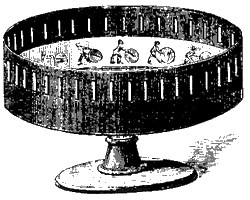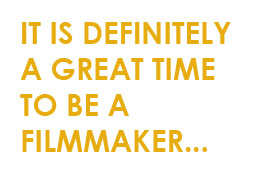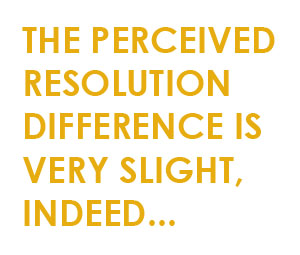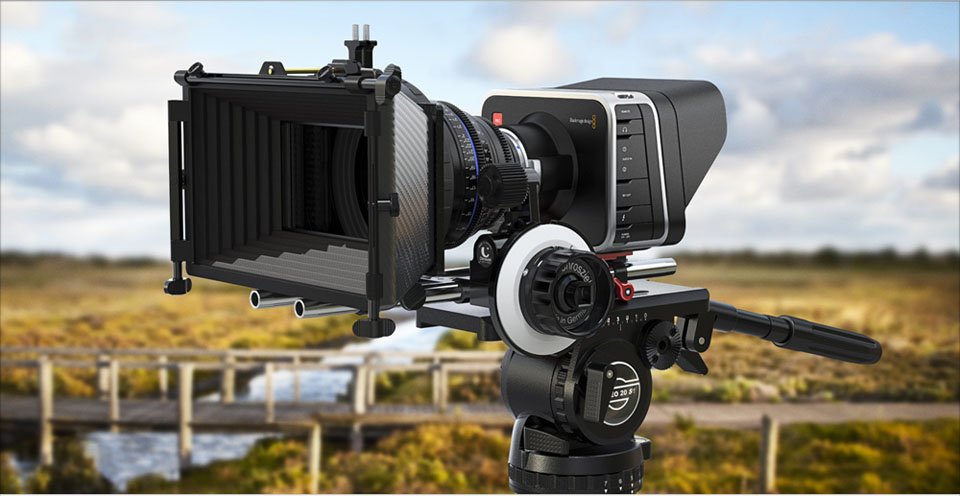The death of DSLR revisited: Blackmagic Design’s new affordable digital motion picture camera
Amid all the shiny new toys announced and demoed at NAB 2012 by the usual suspects of companies such as RED, Arri and Canon, one company not even known for cameras at all lay the smackdown on all the camera manufacturers. Past the initial shock and gadget giddiness, I’ve had a chance to collect my thoughts on this exciting new development.
Blackmagic Design (BMD) -best known for their high end video capture cards and cross converters- unveiled their new Digital Cinema Camera to the shock of everybody at NAB2012. It is a 2.5K camera that shoots in Prores, AVID DNx, and RAW in the ADOBE CinemaDNG format in 23.976/24p/25p/29.97/30p fps. All for $2995 USD. This is big news. Seriously. The key lies in how it shoots and records.
A Nod to the Past and an Eye to the Future
The BMD Digital Cinema Camera’s strength and beauty lies in the fact that it can shoot footage in Adobe’s CinemaDNG format, an open, non-proprietary, non-vendor specific file format. To be absolutely clear, this is not the heavily compressed video stream (like H.264) found in most cameras/camcorders these days. It is in fact an uncompressed image sequence. That’s right! It shoots still images at the various frame rates from 24 to 30 frames/stills per second. Each still image is not only uncompressed, it’s RAW, so it retains a very high level of detail and dynamic range. So Blackmagic’s new camera is by definition a digital motion picture camera; a camera that shoots a series of 2592 x 2192 still images to mimic motion.
 This harkens back to the early days of cinema. During the early days of film back in the 1700’s, there were only still photographs. Then in the mid-1800’s, someone figured out that if one took a series of photographs that showed a change in motion bit by bit and flipped them one after the other really quickly or mount them in a circular drum that rotated them, it would create the illusion that the image is actually moving. This led to the invention of the zoetrope, then the film strip, and then of course the film projector. Thus, motion pictures/moving pictures/movies were born.
This harkens back to the early days of cinema. During the early days of film back in the 1700’s, there were only still photographs. Then in the mid-1800’s, someone figured out that if one took a series of photographs that showed a change in motion bit by bit and flipped them one after the other really quickly or mount them in a circular drum that rotated them, it would create the illusion that the image is actually moving. This led to the invention of the zoetrope, then the film strip, and then of course the film projector. Thus, motion pictures/moving pictures/movies were born.
But a strange thing happened on the way to digital HD video cameras. And the operative word is “video”. All HD and even the 2K and 4K cameras we know today evolved from broadcast video technology. They shoot an electronic video signal via a CCD or CMOS sensor which themselves owe their existence to the vacuum tube. Then manufacturers started compressing these video signals so that more footage can be recorded onto tapes, and then later to cards. But with video compression, a lot of picture detail and dynamic range is lost.
This is why most HD cameras today still look like video. Sure, the invention of progressive frames and the much loved 23.976 frame rate has gotten them to look a LOT closer to film, but they still look closer to video than real film because deep down in their core, they are video cameras shooting and recording either a NTSC or PAL video stream that’s heavily interpolated to try to recover the data that’s lost. But as you know, you can get close with interpolation but you can never fully get back that which was never recorded in the first place.
The Future is… Digital Image Sequences
As funny and old timey as it sounds, the future of filmmaking is Digital Motion Pictures, literally. BMD is not the first company to offer this type of camera. Ikonoskop in Sweden has their A-CAM dll, a HD camera with a 16mm sized sensor that shoots HD in RAW CinemaDNG. But that camera is around $10,000. And the people over at the Digital Bolex Project are getting ready to get their 2K 16mm equivalent, RAW shooting Digital Bolex camera ready for production; a camera that will not only record in CinemaDNG but also TIFF and JPEG image sequences. But that camera is not in production yet. The Phantom high speed cameras also shoot DPX image sequences, but they’re priced between $50,000 to $150,000, depending on the model.
 If BMD sticks to their Fall 2012 target shipping date, then they will be the first one to offer a truly affordable Digital Motion Picture Camera. Offering such a camera at a relatively low price will empower indie filmmakers like never before. RAW image sequence image acquisition will change the current workflow and enable many budget filmmakers to create theatre-quality films of their own with insane levels of post production value that’s never seen before. Imagine being able to do digital effects work by working on the highly detailed still image sequence directly or being able to pull close-to-perfect linear keys from green/blue-screen footage shot with this camera. And by all accounts of people seeing the test footage, it comes really, really close to looking like film.
If BMD sticks to their Fall 2012 target shipping date, then they will be the first one to offer a truly affordable Digital Motion Picture Camera. Offering such a camera at a relatively low price will empower indie filmmakers like never before. RAW image sequence image acquisition will change the current workflow and enable many budget filmmakers to create theatre-quality films of their own with insane levels of post production value that’s never seen before. Imagine being able to do digital effects work by working on the highly detailed still image sequence directly or being able to pull close-to-perfect linear keys from green/blue-screen footage shot with this camera. And by all accounts of people seeing the test footage, it comes really, really close to looking like film.
It is definitely a great time to be a filmmaker! One thing is certain… demand for SSDs are going to skyrocket.
It’s funny, I’ve been keeping tabs on this technology for a while now and this is the direction I was hoping the DSLR manufacturers would go ever since they enabled HD video recording on their cameras. I mean, who better to put out a camera that could shoot RAW stills at 24 or 30 pictures per second than either Canon or Nikon? I really hope they are taking notes from BMD.
There’s Always a Critic
I’ve already heard from some people that the BMD camera is a bit of a letdown because it’s sensor is just slightly (and I do mean just slightly) smaller than a Four Thirds sensor and that it only shoots 2.5K footage.
Firstly, even though its sensor is 16mm sized does not mean it is garbage. Yes, while it is smaller than DSLR sensors, it is still much bigger than most video camera sensors which are tiny in comparison; from 1/2.5 to 2/3 inch sized sensors. As well, having a smaller sensor also means that the image data can be scanned a lot quicker than with the larger sensors, so it should help alleviate the dreaded rolling shutter/jello-cam effect that plagues the DSLR’s large sensors.
The only issue I can see is getting a good wide angle lens for it. With basically a 2x crop factor, a 8mm (full frame format) fisheye lens becomes a 16mm one. But since the mount is Canon EF compatible, you can bet there will be an adapter made available that will allow you to use any one of a plethora of lenses out there, including some excellent Micro 4/3 lenses like the Voigtlander’s awesome Nokton F0.95/17.5mm lens or the Leica-branded 25mm Summilux f/1.4 lens.
 Secondly, as for the “it’s only 2.5K” argument, we are talking about an image size of 2592 x 2192. 2592 x 2192 -that’s still pretty big! Most people cannot tell the difference between HD and 4K resolution projected on a theatre screen. Legendary director Martin Scorsese shot his movie HUGO on the Alexa in HD resolution because he saw a test (projected on a theatre screen) which compared HD footage and the 3K ArriRAW footage – and he DID NOT SEE MUCH OF A DIFFERENCE. In fact, working as a Digital Cinema Camera Technician myself, I have been fortunate to have participated in similar HD vs 3K/4K tests via a 4K projector on a large theatre screen and you know what? The perceived resolution difference to the naked eye is very, very slight indeed. It took a LOT of staring into the fine details to be able to spot the difference. And even then, you would have to get really, really close to the screen to be able to see the real difference.
Secondly, as for the “it’s only 2.5K” argument, we are talking about an image size of 2592 x 2192. 2592 x 2192 -that’s still pretty big! Most people cannot tell the difference between HD and 4K resolution projected on a theatre screen. Legendary director Martin Scorsese shot his movie HUGO on the Alexa in HD resolution because he saw a test (projected on a theatre screen) which compared HD footage and the 3K ArriRAW footage – and he DID NOT SEE MUCH OF A DIFFERENCE. In fact, working as a Digital Cinema Camera Technician myself, I have been fortunate to have participated in similar HD vs 3K/4K tests via a 4K projector on a large theatre screen and you know what? The perceived resolution difference to the naked eye is very, very slight indeed. It took a LOT of staring into the fine details to be able to spot the difference. And even then, you would have to get really, really close to the screen to be able to see the real difference.
Why is that you might ask? Because our eyes tends to blur details at a distance. This is at the heart of a debate that is currently being argued in Imaging Technology; whether the human eye can actually resolve the extra detail in a 4K projected image. All signs seem to be pointing to no. Time and time again with these resolution tests on new cameras, people sitting at a regular viewing distance from a theatre screen cannot distinguish between films shot in HD/2K and 4K. The only way they could actually see all that extra detail is if they physically get really close to the screen, or the image gets zoomed in to magnify those extra details. And you know what, no one watches movies in theatres from the first 2 rows anyway.
Now couple that with the Bayer patterning most cameras currently employ on sensors (which effectively reduces the density or number of pixels on a sensor surface that can record each red, green and blue component of light) and the complex compression schemes used in cameras/camcorders and you will notice how misleading the whole 4K argument is. What these tests did show me was how important colour and dynamic range is, much more than resolution. So give me colour and dynamic range over “high” resolution any day!
By the way, if you are interested in reading more about this resolution phenomenon, check out the amazing article “The Truth about 2K, 4K and the Future of Pixels” by John Galt, an expert and pioneer in digital imaging who helped develop the Panavision version of Sony’s HDW-F900 camera and led the team in the creation of the Genesis Camera. He definitely knows his stuff.
So How Do You Handle All Those Images?
So one question you might be asking is, with a camera like this where does it store all that wonderful, uncompressed data? This camera shoots directly on ordinary Solid State Drives (SSDs) that you can pick up at a computer store/outlet. No redesigned custom interface (hear that Sony?), the same industry standard SATA interface that every off the shelf SSD uses. Just pop one in and away you go, shooting to your heart’s content. And by the way, it doesn’t have those pesky recording time limits that DSLRs have.
So you may be asking, how do you edit footage shot as still image sequences? There are several ways to do this. The first and most obvious method is to use the colour correction software Resolve, a $999 software package that is included free with every BMD Cinema Camera. With Resolve, you can create a proxy file that links to the image sequence. The proxy file then acts like a video file, allowing you to edit much in the same way. You import the proxy file into your editing software and edit. But it differs in that it does not contain any video/picture data -it just points to the image sequence of RAW stills when the editing software needs it. Another way of handling the image sequences is to use your editing software or an animation program to import the entire sequence of images and create a video file that you use to edit. Or you can just shoot Apple ProRes or Avid DNxHD video files and edit with that. As you can see, there are many options available to help you edit the footage.
The Death of DSLR Filmmaking?
As opposed to last year at NAB when several manufacturers offered up several new HD video cameras with those large DSLR-sized sensors, many in the industry prematurely proclaimed that the HD-DSLR was dead. Unfortunately that was not the case because those new cameras came with fairly high price tags compared to their DSLR counterparts. The charms of HD-DSLRs were their ability to shoot beautiful images with a host of interchangeable lenses at a very low price.
I even noted in my “Death of DSLRs?” article last year that…
“The only way the DSLRs are really going to die is if there comes a camera that will house the 35mm sensor in a proper video camera-type body AND will be the same price or cheaper than a DSLR. …Then again, maybe a cheap 2K/4K camera will come out and plow everyone else aside.”
The BMD Cinema Camera appears to be that camera. It has left many in shock just after its announcement. With all its brilliant features, it is the closest thing that can stem the tide of people using DSLRs for video. But it will not stop everyone from using DSLRs for video. The BMD Cinema Camera is still a $3000 camera. As much of a bargain it is for that type of camera, there are people out there who cannot afford it. When you can buy a Canon T2i for roughly $500, DSLR filmmaking is still far, far from dead.
Never has there been a shakeup this big since DSLRs were able to shoot HD video. And with a $3000 price tag, Blackmagic has taken aim squarely at prosumer HD-DSLRs. For the first time, indie filmmakers can finally afford a camera that will enable them to produce those theatre quality masterpieces they previously only dreamt of.
More info on:
Blackmagic Digital Cinema Camera
Adobe’s CinemaDNG






